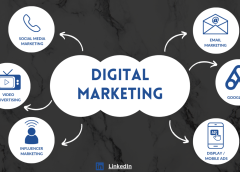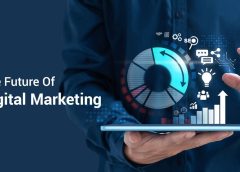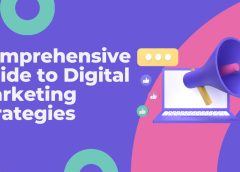In today’s fast-paced digital world, marketing your business effectively online is not just an option; it’s a necessity. With countless strategies, tools, and platforms available, understanding the ins and outs of digital marketing can feel like navigating a complex maze. But fear not! In this guide, we’ll break down the essentials of digital marketing, from the different types and where to use keywords to the main methods that drive results.
Types of Digital Marketing: Let’s start by exploring the diverse landscape of digital marketing. There are several key types to consider:
Search Engine Optimization (SEO): This is the art and science of optimizing your website to rank higher in search engine results pages (SERPs) organically. By carefully selecting and strategically placing relevant keywords, creating high-quality content, and improving technical aspects of your site, you can attract more organic traffic and improve your visibility online.
Social Media Marketing (SMM): Social media platforms like Facebook, Instagram, Twitter, and LinkedIn offer unparalleled opportunities to connect with your audience. With SMM, you can engage with your followers, build brand awareness, and drive traffic to your website through compelling content and targeted advertising campaigns.
Content Marketing: Content is king in the digital marketing realm. Whether it’s blog posts, videos, infographics, or podcasts, creating valuable and relevant content can help you attract and retain customers. By addressing their pain points and providing solutions, you can establish yourself as an authority in your industry and build trust with your audience.
Email Marketing: Despite the rise of new marketing channels, email remains one of the most effective ways to reach your audience directly. By sending personalized and engaging emails, you can nurture leads, build relationships with customers, and drive sales.
Pay-Per-Click Advertising (PPC): PPC advertising allows you to bid for ad placement on search engines and other digital platforms. With PPC, you only pay when someone clicks on your ad, making it a cost-effective way to drive targeted traffic to your website and generate leads.
Utilizing Keywords for Maximum Impact:
Keywords are the foundation of any successful digital marketing strategy. Here’s where and how you can use them to drive more traffic to your website:
Website Content: Incorporate relevant keywords naturally into your website content, including blog posts, product descriptions, and landing pages. This will help improve your search engine rankings and attract more organic traffic.
Meta Tags and Descriptions: Optimize your meta tags, meta descriptions, and title tags with target keywords to improve your click-through rates and signal to search engines what your content is about.
Social Media Posts: Use keywords in your social media posts and profiles to increase your visibility and engagement on social platforms. This will help more people discover your content and drive traffic to your website.
Paid Advertising Campaigns: Conduct keyword research to inform your PPC campaigns and ensure your ads are shown to people actively searching for products or services like yours. This will help you maximize your advertising budget and increase your chances of conversion.
Primary Methods of Digital Marketing:
Now, let’s explore the two primary methods of digital marketing:
Inbound Marketing: Inbound marketing focuses on attracting customers through valuable content and experiences rather than interruptive advertising. By creating content that resonates with your target audience and addressing their needs and interests, you can attract, engage, and delight customers throughout their buying journey.
Outbound Marketing: In contrast to inbound marketing, outbound marketing involves reaching out to potential customers through traditional advertising channels such as television, radio, print media, and cold calling. While outbound marketing tactics can be more intrusive, they can still be effective when targeted and tailored to the preferences of your audience.
Certainly! Let’s delve deeper into some additional aspects of digital marketing:
Measuring Success: One of the key advantages of digital marketing is the ability to track and measure the performance of your campaigns in real-time. Through analytics tools like Google Analytics, you can gain valuable insights into various metrics such as website traffic, conversion rates, and user engagement. This data allows you to identify what’s working well and what needs improvement, enabling you to refine your strategies for better results.
Mobile Optimization: With the increasing prevalence of smartphones and tablets, optimizing your digital marketing efforts for mobile devices is crucial. This includes ensuring that your website is mobile-friendly, your emails are responsive, and your ads are well-suited for smaller screens. By catering to the needs of mobile users, you can enhance their experience and maximize your reach across different devices and platforms.
Personalization: In today’s hyper-connected world, consumers expect personalized experiences from the brands they engage with. Digital marketing offers numerous opportunities for personalization, from targeted email campaigns based on user behavior to customized ad content tailored to individual preferences. By delivering personalized messages and offers, you can foster stronger connections with your audience and increase the likelihood of conversion.
Social Proof: Social proof plays a significant role in influencing purchasing decisions in the digital age. Positive reviews, testimonials, and user-generated content can help build trust and credibility for your brand. Leveraging social proof in your digital marketing efforts, such as showcasing customer testimonials on your website or highlighting positive reviews on social media, can help instill confidence in potential customers and drive conversions.
Continuous Learning and Adaptation: The digital marketing landscape is constantly evolving, with new technologies, platforms, and trends emerging regularly. To stay ahead of the curve, it’s essential to embrace a mindset of continuous learning and adaptation. Stay updated on industry news, experiment with new strategies and tactics, and be willing to adjust your approach based on feedback and results. By staying agile and proactive, you can ensure that your digital marketing efforts remain effective and relevant in an ever-changing environment





